Realizing Children’s Rights in Pakistan


Pakistan has over 80 million children and is suffering to fulfil their needs. Children in Pakistan are vulnerable to several development challenges impacting their safeguarding including: quality of education, prevention of sexual exploitation of children, child trafficking, marriage, and labour.

Children’s Rights Index : 5.46 / 10
Black level : Very serious situation
Population: 204 million
Pop. ages 0-14: 34 %
Life expectancy: 66,6 years
Under-5 mortality rate: 66 ‰
Pakistan at a Glance
Pakistan is a country in South Asia with a coastline along the Arabian Sea and the Gulf of Oman. It has Afghanistan and Iran to the west, China to the north, and India to the east. The population of Pakistan has significantly increased over the years and is 2.65% of the total world population, approximately 204 million in 2019. The young population, between the ages of 0 to 24, accounts for 52.50% of the total population in Pakistan.
Created during the partition of India in 1947, Pakistan remains a relatively unstable democracy threatened by sectarian and terrorist violence, and it has faced both domestic political upheavals and regional confrontations.
Early adoption of socialism as the economic goal and the recurring military takeovers of the government makes Pakistan appear to be unstable. However, after the Islamic Republic of Pakistan announced its independence in 1947, the country notably developed in many aspects too such as health services, education, life expectancy, literacy, and infant mortality rates.
Pakistan still faces several development challenges impacting the safeguarding of children including; quality of education, prevention of sexual exploitation of children, child trafficking, marriage, and labor. Despite everything, the full realization of Children’s Rights is still going to demand enormous time and effort.
Status of Children Rights
Pakistan has over 80 million children and is suffering to fulfill their needs. This makes it crucial for interventions and policies to champion the rights of children efficiently. Only 20.88% of children live in urban areas and have access to fundamental needs.
Furthermore, 24% of the entire Pakistani population lives below the poverty line, which mainly affects rural areas. In the country, the state of the global markets is exacerbating an already very difficult economic reality. So, the rest of the children who live in rural areas are usually deprived of various resources such as clean water and food, education, and health services.
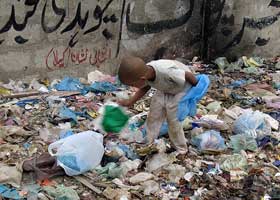
On 12 November 1990, Pakistan enacted the Convention on the Rights of the Child , making a reservation on translating its terms following the principles of Islamic laws and values. This was a significant achievement concerning children-rights. However, just after 7 years, in 1997, Pakistan decided to withdraw its reservation. In 2009, the Committee on the Rights of the Child welcomed Pakistan’s pledge to increase the allocation of sources for children. The Committee, however, had expressed concerns over notably low budget allotments for children, which undermined Pakistan’s initial prospects.
Moreover, the Committee asked Pakistan to initiate budget tracking from a child-rights perspective. After this action, child-rights became a subject that was more concerned upon. Although steps have been taken to improve the conditions of children, there are still many rights and needs that have to be approached. Given the percentage of children and the growing number of births in Pakistan each year, it is imperative that the rights of these newborns and children are protected.
Child-sensitive Social Protection
Social protection is essential for preventing and reducing poverty for children and families, for addressing inequalities, and for realizing children’s rights. In addition, it is essential that social protection programs respond to children’s vulnerabilities by optimizing positive effects on children and minimizing potential adverse consequences. Pakistan faces immense challenges in terms of poverty reduction as they lack in many of the basic human, physical, and productive assets and have restricted or no access to essential social service.
However, especially if child-sensitive social protection is put into action correctly, it has the opportunity to address chronic poverty, social exclusion, and external shocks which can irreversibly affect children. One of the leading causes of death, malnutrition is newly starting to be addressed. Social protection programs are now involved in the government’s poverty mitigation strategy, along with social welfare programs and human resources development, which include a focus on children’s health and nutrition.
For example, the National Social Protection-for-Results Project, which was established in March 2017 by the government, is a social protection program aimed to strengthen the social safety net systems for the people who live in poverty and to enhance their access to complementary services.
Another program that is called BISP, Benazir Income Support Programme, supported by donors and local researchers, aims to help women in poor households. This program has had an impact on the cash transfer on food and nutrition of households, which has positively affected 80% of the problem of malnutrition concerning many children in Pakistan. Despite this, many children and families continue to face barriers accessing basic social services.
Although some forms and policies of social protection in Pakistan are child-sensitive, it is still inadequate for the children’s needs. As such, it is important that policies, legislation, and regulations effectively consider the viewpoint of children, youth, and their caregivers- so that children’s rights are met.
Addressing the Needs of Children
Right to Health
In Pakistan, a child’s right to health is endangered from their youngest age. Approximately one child out of six dies before the age of five. These deaths are ordinarily caused by malnutrition or the lack of access to clean water and supplies. Every day, around 1,100 Pakistani children die from diarrhea and illnesses related to water, sanitation, and hygiene. Another factor provoking the early deaths of Pakistani children is the nutritional status of children in Pakistan.
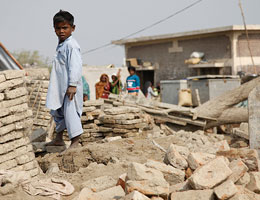
It is clear that this situation is considerably dire in Pakistan, with stunting and wasting profoundly common in the country; 30% of the children are underweight, more than 50% suffer from stunted growth and around 9% from emaciation. Access to care is a challenge in most rural areas where many families cannot afford primary healthcare which deteriorates the conditions in which children live.
Moreover, recurring natural disasters have a substantial impact on the health of people as well as infrastructures. Also with 11 million children performing domestic tasks and working in agriculture, and many others working in the textile industry, child labor is a significant factor of health. They work in very cramped conditions and places detrimental to their health. So it is not uncommon for them to suffer from respiratory and vision problems, or even deformations of their spinal columns.
Right to Education
Pakistan’s education is improving; however, it is not sufficiently advanced yet. With 23 million children unable to go to school, only 71% of children attend primary school in Pakistan. The government allocates 1.8% of its national budget to education, which is undoubtedly insufficient considering the urgent need. The difficulties of public education are numerous: economic constraints, dilapidated or even dangerous buildings, lack of toilets, chairs, tables, recurring humanitarian crises, etc.
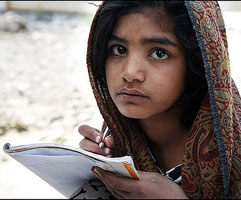
Furthermore, teachers are very under-qualified, and it is not uncommon for children to leave school without knowing how to read or write. This is the case for almost half of school-going children in Pakistan. As an addition, Afghani refugees in Pakistan are invisible under Pakistani law and so are deprived of school and have to work to survive. Having a population of 45% composed of people who are younger than 20 years old, the risk, at this moment, is to turn against society. This can also manifest itself in radicalized thoughts.
Right to Identity
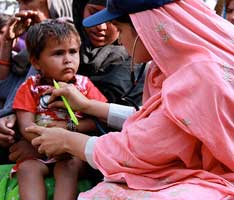
In Pakistan, there are many “invisible” children, children who are not recognized by the Pakistani law because their births are not recorded. Around 70% of deliveries are not officially reported to the Pakistani public authorities. The deficiency of regulations on births and a scarcity of information about the need to register children are the biggest obstacles in front of the realization of a complete birth registry. There is a great necessity to inform the general public about the problems that this could cause, such as the absence of official identity, nationality, or even the failure to respect the rights and practical needs of children.
Birth registration is a fundamental right as it provides the child a name, parentage, nationality, and age. It also represents a proof of identity, a sign of existence in the eyes of society, granting them automatic protection from the government against trafficking and forced labor.
Risk factors → Country-specific challenges
Poverty, malnutrition, and access to water
Sufficient nutrition and a constant supply of water are essential for a child’s development, and the absence of these elements can directly impact the child’s health. Not only the child but if the mother suffers from poor nutrition, it may significantly affect the baby in the womb or the child that is being breastfed. Some of the most prevalent problems that cause child deaths are malnutrition and the inability to access clean, fresh, and consistent water.
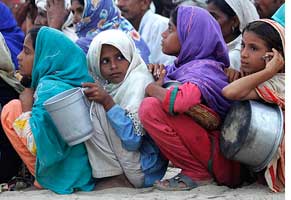
According to the IMF, International Monetary Fund, Pakistan is in third place for acute water shortage, and this scarcity is significantly impacting the population. Each day, approximately 1,100 Pakistani children die from diarrhea and illnesses related to the quality or quantity of water. Because of malnutrition, currently, in Pakistan, 30% of the children are underweight, more than 50% suffer from stunted growth and around 9% from emaciation. With 24% of the population living below the poverty line, poverty is one of the main reasons that many people in Pakistan suffer from, and it leads to many problems that may be significant risks to the population, especially children.
Socioeconomic status and its effect on children
Yearly income for the majority of Pakistani citizens have been and still is very low compared to many countries. The GNI, gross national income, per capita in Pakistan in 2017 was US 1600 dollars, and Gross domestic product per capita annual growth rate during 2001- 2018 was 5.4%. Although this percentage has increased through the years, it is still low and may cause problems for future generations.
Also, as for the expenditure of the government, in 2018, the government only allocated 3% of its budget to health services and another 3% for education. Altogether, taking into account the socioeconomic status of individuals and the inadequate support the government is providing for the development of the children both mentally and physically, the children are born into a system with risks of its own.
Child marriage and violations of the law
The floods in 2010 had a very negative effect on people in Pakistan and especially the families who were already in poverty. Laws concerning child marriage had already been broken but after the crisis, it became increasingly common to marry girls below the age of 16 and boys below the age of 18. This was primarily because of the increased rates of poverty and the families not being able to look after their children.
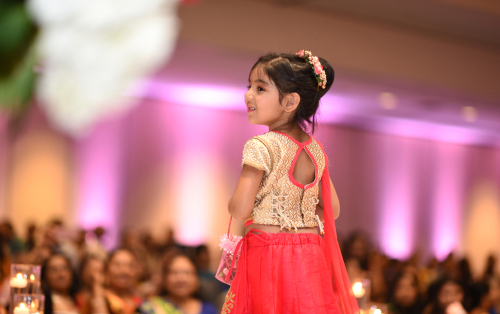
With more parental negligence, corporal punishment, lack of awareness among children and society, and the absence of legal protection of children the “Child Marriage Restraint Act” is being overlooked by both the government and families. It is also seen that some country-specific drivers of this are traditional customs, gender norms, family practices, and levels of education.
A significant amount, 32%, of marriages in Pakistan are actually child marriages. For example, in rural areas, sometimes you can even observe a practice called “Vani Marriages”, which involves giving your daughter in marriage to settle a dispute or a debt between two parties. “The aggressor” offers one of his family’s daughters in compensation for a wrong caused. These marriages are very dangerous for the health of young girls who, as a result, run the risk of domestic violence, servitude, and rapes increasing child trafficking.
Written by Yagmur Ozturk
Last updated on 29 November 2019
References:
UNICEF. (2017). Situation Analysis of Children in Pakistan.
Shujaat, Q., & Mirza, K. (2015). The State of Children in Pakistan.
Roth, K. (2019, January 17). World Report 2019: Rights Trends in Pakistan.
Pakistan (PAK) – Demographics, Health & Infant Mortality. (n.d.).
Girls Not Brides. (2019, August 16). The side of Pakistan you don’t see.

